The technique of brewing black coffee how to make a perfect cup of coffee
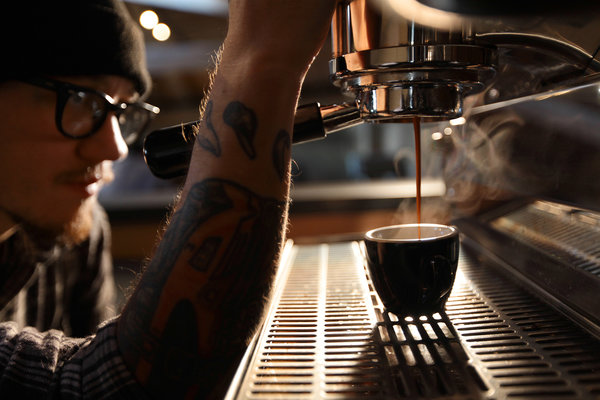
[P] Tristan J. Wallage, known as Ant, teaches people how to make coffee in San Francisco. Jim Wilson/The New York
Times[ / p] [/ p]
San Francisco
Tristan J. Wallage (Tristan
Walach) has a tattoo on his neck, which is the famous welcome sign in Las Vegas. People usually call him "Ant". He specializes in teaching people to make coffee.
And I'm here to learn from him.
"people like you are the best to train," he said, looking at me. "you have no bad habits and no preconceptions. You are a blank piece of paper. "
We are at the Lens Cafe near downtown San Francisco, and there is a huge coffee roaster next to the front door. But Ant and I were hiding upstairs, and a chain cut us off with a sign saying, "training is in progress."
Such training centers are becoming more and more common, not only in coffee shops, but also some coffee shop clerk certificate training courses, and even "make a cup training camp", which is a four-day and three-night event. In addition, there are more and more regional and national "challenges" looking for the most skilled, elegant and able to make the most delicious coffee.
Am I a little skeptical about this? Well, making coffee, even espresso, is basically adding water and stirring to the coffee beans, sometimes just turning on a switch or pressing a button. Come on, Ant, whet my appetite and convince me to take three days to take a course like "Cereal training Camp".
And, well, I'm not exactly a blank piece of paper. Without training, I can make a decent latte every morning. And I boasted to my wife that I only use a $100 coffee machine and coffee beans from any local coffee shop, which is better than Starbucks.
"how hard can it be to make coffee? This is an attitude we've been facing, "said Ellie, director of professional development at the American Fine Coffee Association (Specialty Coffee Association of America).
Matuszak) said. The association is an industry group with thousands of members and a growing baristas association with 1200 members.
The 34-year-old ant, whose title is director of training, says it takes dexterity to make coffee. "this is the most complex drink we consume." He said.
The training center of Perspective Mirror has a counter with several grinders, a professional, high-quality espresso machine, a scale, coffee hammers and other wardrobes. On a piece of primary recycled wood, there are ten cups without handles, divided into five pairs, each containing half-full beige coffee beans.
But first, we need to see Ant make a slide show about where the best coffee beans come from and how they are selected. There is a slide entitled "Story of the place of Origin" (Origin
Myth). It's a folktale in which an Ethiopian shepherd discovered coffee and promoted it.
Then there is the study cup test.
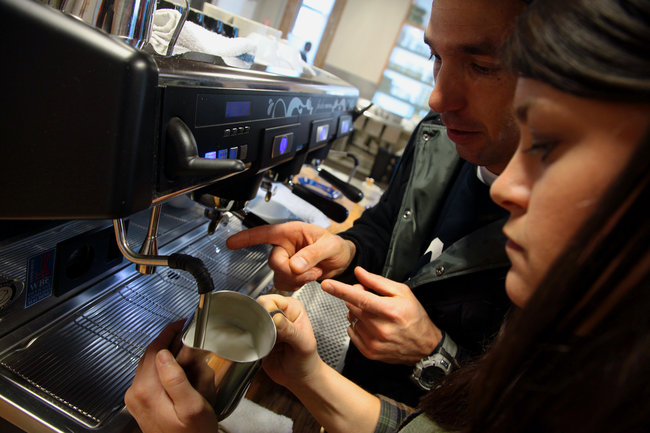
Chris Vaca teaches new employees how to foam properly at the verve Cafe in Santa Cruz.
Jim Wilson/The New York Times

We need to smell what's in these white cups-coffee beans from Kenya, Costa Rica, Ethiopia, El Salvador and Guatemala. I can't smell the difference.
Then Ant began to teach me how to use the "La Marzocco Linea" fully automatic coffee machine, which is an espresso machine worth between $8000 and $10000 (the really expensive "La"
Marzocco Strada "and" Slayer "pressure swing extractors are downstairs for real baristas. On its left is a $1500 Mazzer.
The "Major" bean grinder has a button on it. My job is to press that button to accurately mix 19.5 grams of coffee powder into the filter.
I need to sift through the coffee powder a little, shake it flat, and then tamp it with a tamper. The ant showed me how to generate a pressure of about 35 pounds. To produce this weight, I needed to bend my knees and squeeze the hammer until I felt the coffee powder bounce back.
Ant says this step is crucial, otherwise the water will seep unevenly into the coffee powder, creating extra cracks. I pressed another button to let the water seep into the coffee powder. We set the timer to make sure that the time to let the water permeate was 25 seconds. The brown and yellow espresso flows into the small coffee cup, which the ant calls the "test cup".
The ant took a sip. "it's not that bad."
I took a sip, too. In fact, it tastes really bad, sour and bitter. The ant made a cup with the same steps, but a faint sweet fragrance floated out, close to the fragrance of the flowers, with no superfluous taste. I made another drink, and it was still as bad as my first one. Maybe I need some milk.
The ant began to explain how to make milk foam. To put it simply: put the steam nozzle just below the milk noodle until the milk begins to whirl after absorbing the steam, and then put the nozzle a little deeper until the temperature of the milk on the thermometer reaches 135 degrees. The temperature of milk has a best meeting point, at which the sugar can be boiled, but not scorched, making the milk sweeter.
I tried it several times and got water-like milk and poured it on the bitter coffee. Finally, I got the concentration of the milk right, just like wet paint. I tried to draw some lattes on it to look like two mating amoebas.
Ant said earnestly, "the difference between a good barista and a great barista is that a great barista dares to pour out a cup of coffee." So we poured my amoeba into the sink.
I have a second chance. I told Ant that I was going to talk to Chris Vaca (Chris) in verve.
Baca) learn more, which is a roaster and coffee shop in Santa Cruz. His eyes lit up at once. "he's wonderful! I trained with him. " He said.
But first, I tried to practice what I had learned at home the next morning. I poured out the first three cups and there was something wrong. I was able to make delicious espresso the other day, but I actually went backwards.
Vaca, 32, had planned to be a high school history teacher. But he dropped out of college and got a job in a coffee shop in Modesto. He gradually fell in love with coffee and moved to San Francisco to work for a trendy coffee shop called Ritual, then started competing in 2006. In 2010, he was at the American baristas Championship (United)
States Barista Championship) won the second place among the 50 contestants. In the free project, he made a cup of English cream espresso topped with cherries and oranges.
"I know it all looks like Best in Show," said Ryan, the owner of the Verve Cafe.
O'Donovan) said of a fake documentary film about the dog show, "it's ridiculous, we're trying to make it less ridiculous."
Vaca is the director of training at verve, where 1500 square feet of space is used as a training base. This is part of what the cafe calls the "third wave" of the coffee movement-the first wave is campfire.
Coffee) and dripping Coffee (drip coffee), the second wave was the Starbucks revolution, and then set off a culture of understanding the richness of coffee. O'Donovan said that training is "the core of our work."
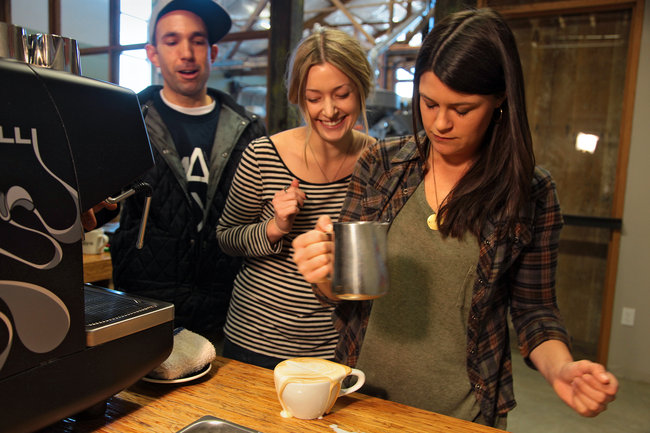
In a training class, a cup of coffee was full of water.
Jim Wilson/The New York Times

I showed Vaca what I had learned before. He said my first drink was a little dry. He's so kind.
Vaca asked me to bring my usual brand coffee beans and use them to make a cup. It didn't taste good. This is the first lesson: coffee beans are important. The package says "Fair Trade" (fair
Trade) or "baking of origin" (locally)
Roasted) does not mean picking out the best coffee beans and roasting them carefully. We threw my $13-a-pound bag of coffee beans into the dustbin. Then Vaca began his math class.
The essence of a good espresso, or any good coffee, lies in three data: the amount of high-quality dried coffee beans used, the time it takes to seep through, and the amount of coffee eventually made. When the proportion of these three is right, the processing process can bring out the best flavor. If wrong, the fragrance either won't come out, or it will be diluted. It dawned on me that the mistake in seconds and grams is the difference between delicious and bad coffee.
Vaca explains that you have to experiment to find the right balance between a specific coffee machine and a certain grinding powder, and then you can follow suit. He tested the lens machine and determined that we would use 17 grams of top coffee beans and then pass through the water for 25 seconds to make about 30 grams of coffee.
It also looks simple, because the grinder is set up to grind out the grams I want, and I can confirm it with a scale. All I have to do is press the button. My first cup still didn't taste right, but Vaca said my second one was "fresh and full".
He showed me how to draw with milk foam: place the thin-necked bottle 6 inches high from the noodles, pour out medium-flow coffee evenly, and let the mouth of the bottle slowly approach the cup when the cup is half full. When the cup is almost full, twist your hand quickly to let the foam take shape, and finally gently wave it to draw a line in the middle of the milk pattern. After a few attempts, I was able to make something that looked like a pine tree, even though I wanted to draw a heart.
Great. I'm making progress. But it doesn't make any practical sense. The coffee I bought is pre-ground, and I don't have a scale.
"A $10 scale is the most worthwhile investment when you play coffee," Vaca says. 'Because the density and quantity of coffee beans are very important, it won't be long before I need another grinder,'he said. Some experts say freshly ground coffee powder is the most important element.
The truth is: my family is usually very busy in the morning, the family is noisy, and I have to make coffee in this environment. O'Donovan was amused. He said, how is it possible to make espresso in the morning? Not to mention the latte.
"I can make drip coffee," O'Donovan explained. So is Vaca. This is because making a good espresso requires careful preparation and cleaning up afterwards. Even if all goes well, it still takes some time, just like cooking a good meal.
"Coffee is more than coffee." O'Donovan said.
It's "just like everything," echoed Baca.
I immediately understood what he meant: coffee, which I think is a simple necessity at the beginning of the day, is much more complicated than a few beans and water. It may not need a license, but it does take more effort than I thought.
At the end of my training course, O'Donovan threw me a laugh and warned me, "you are walking towards a bottomless pit."
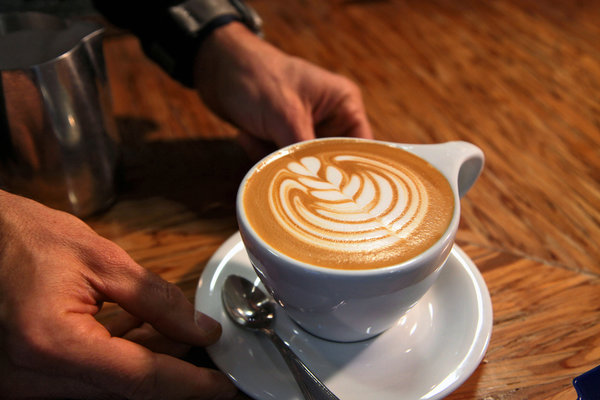
Vaca shows off a cup of coffee made by him at the verve Cafe.
Jim Wilson/The New York Times

The day after that, I started putting a timer on the microwave to make sure it took 25 seconds to make my espresso. I searched the Internet and discussed with others what kind of coffee machine I should use next. But even with my old machine and some coffee beans left over from the lens, my coffee has improved significantly, and sometimes it tastes good.
I placed an order for coffee beans from the verve coffee shop. When two bags of different kinds of coffee arrived, I looked excited and my wife rolled her eyes. She wondered if I could tell the difference between these new beans and the other two kinds of coffee I used to make do with. So we had a blindfold test.
I won. My wife seems surprised: who is this man with such a good nose? I told her, this is just the beginning, you have to see what else we can do with milk.
Important Notice :
前街咖啡 FrontStreet Coffee has moved to new addredd:
FrontStreet Coffee Address: 315,Donghua East Road,GuangZhou
Tel:020 38364473
- Prev
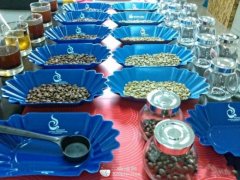
Basic knowledge of coffee tasting of fine coffee technology
Here, I do some common sense popularization. Very often, you will hear a lot of coffee lovers who don't know anything, so they can go to the store and yell, boss, do you have Kopi Luwak? It's Kopi Luwak I drink every day. There are also some coffee lovers with deep expectations for their own coffee. It is trumpeted that Yunnan coffee is comparable to Blue Mountain. These are all quite arbitrary and crude.
- Next
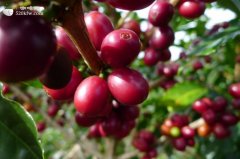
Taste boutique coffee bean technology coffee cup test 90 +
NinetyPlus, literally translated as 90 cents, means that the young coffee company sells raw coffee beans with a Cupping score of more than 90 points. Some friends may think that it is not a big deal to score more than 90 points, but if they understand this set of Cupping rules, they will keep their mouth shut: after more than a dozen strict requirements of the inverted deduction system, the remaining 90 points is no less difficult than writing.
Related
- What is the meaning of lactic acid fermentation with coffee bean treatment?
- How to judge the state of foam by sound?
- How does the latte pull out the unicorn pattern? Come to get for a little trick to improve the flower pull!
- Will flower pulling affect the taste of the latte?
- Do you know the history of coffee?
- The difference between honey treatment and sun washing what is raisin honey treatment?
- What kind of milk can a novice use to make coffee foam to keep the foam longer? The correct method and skills of milking tutorial sharing
- Why do washed coffee beans taste sour? Flavor characteristics of washed Coffee
- Introduction to the skill of how to practice the size and height of water injection around the circle of hand-brewed coffee
- How do beginners practice coffee flower drawing from scratch?

